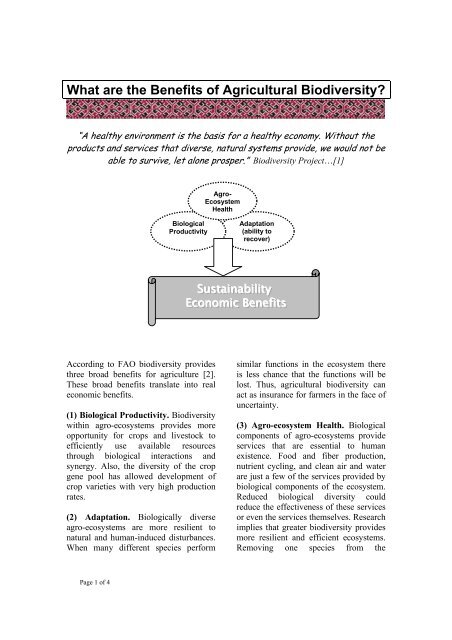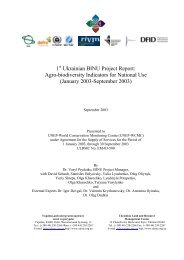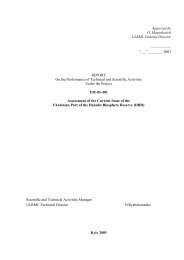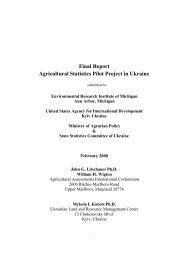What are the Benefits of Agricultural Biodiversity?
What are the Benefits of Agricultural Biodiversity?
What are the Benefits of Agricultural Biodiversity?
Create successful ePaper yourself
Turn your PDF publications into a flip-book with our unique Google optimized e-Paper software.
<strong>What</strong> <strong>are</strong> <strong>the</strong> <strong>Benefits</strong> <strong>of</strong> <strong>Agricultural</strong> <strong>Biodiversity</strong>?<br />
“A healthy environment is <strong>the</strong> basis for a healthy economy. Without <strong>the</strong><br />
products and services that diverse, natural systems provide, we would not be<br />
able to survive, let alone prosper.” <strong>Biodiversity</strong> Project…[1]<br />
Agro-<br />
Ecosystem<br />
Health<br />
Biological<br />
Productivity<br />
Adaptation<br />
(ability to<br />
recover)<br />
Susttaiinabiilliitty<br />
Economiic Beneffiitts<br />
According to FAO biodiversity provides<br />
three broad benefits for agriculture [2].<br />
These broad benefits translate into real<br />
economic benefits.<br />
(1) Biological Productivity. <strong>Biodiversity</strong><br />
within agro-ecosystems provides more<br />
opportunity for crops and livestock to<br />
efficiently use available resources<br />
through biological interactions and<br />
synergy. Also, <strong>the</strong> diversity <strong>of</strong> <strong>the</strong> crop<br />
gene pool has allowed development <strong>of</strong><br />
crop varieties with very high production<br />
rates.<br />
(2) Adaptation. Biologically diverse<br />
agro-ecosystems <strong>are</strong> more resilient to<br />
natural and human-induced disturbances.<br />
When many different species perform<br />
similar functions in <strong>the</strong> ecosystem <strong>the</strong>re<br />
is less chance that <strong>the</strong> functions will be<br />
lost. Thus, agricultural biodiversity can<br />
act as insurance for farmers in <strong>the</strong> face <strong>of</strong><br />
uncertainty.<br />
(3) Agro-ecosystem Health. Biological<br />
components <strong>of</strong> agro-ecosystems provide<br />
services that <strong>are</strong> essential to human<br />
existence. Food and fiber production,<br />
nutrient cycling, and clean air and water<br />
<strong>are</strong> just a few <strong>of</strong> <strong>the</strong> services provided by<br />
biological components <strong>of</strong> <strong>the</strong> ecosystem.<br />
Reduced biological diversity could<br />
reduce <strong>the</strong> effectiveness <strong>of</strong> <strong>the</strong>se services<br />
or even <strong>the</strong> services <strong>the</strong>mselves. Research<br />
implies that greater biodiversity provides<br />
more resilient and efficient ecosystems.<br />
Removing one species from <strong>the</strong><br />
Page 1 <strong>of</strong> 4
ecosystem may appear to have no effect,<br />
but <strong>the</strong> complex interactions among<br />
different species may cause <strong>the</strong><br />
ecosystem to change in ways we cannot<br />
imagine.<br />
(4) Economic <strong>Benefits</strong> USAID [3]<br />
estimates that biodiversity provides at<br />
least 16 trillion UAH, or nearly 11% <strong>of</strong><br />
<strong>the</strong> world Gross Domestic Product. Loss<br />
<strong>of</strong> biodiversity and related ecosystem<br />
functions can generate huge economic<br />
costs. For example, polluted air and<br />
water increase illness and reduce<br />
productivity. Lost pollinators may be<br />
.<br />
irreplaceable or replaceable at a<br />
prohibitive cost. Degraded ecosystems<br />
lose <strong>the</strong>ir capacity to filter and store<br />
water, and cycle nutrients. This can force<br />
cities to build expensive water treatment<br />
plants and farmers to import expensive<br />
fertilizers or reduce crop yields.<br />
A very important benefit <strong>of</strong> biodiversity<br />
is “potential future value”. Some species<br />
have <strong>the</strong> potential to provide tremendous<br />
future benefits. We don’t know which<br />
species will provide <strong>the</strong>se benefits, so it<br />
is important to preserve as many <strong>of</strong> <strong>the</strong>m<br />
as possible.<br />
Some specific benefits <strong>of</strong> agricultural biodiversity<br />
Crop Genetic<br />
Diversity (1)<br />
Wild Plant<br />
Diversity (2)<br />
Genetic diversity (variation within crop<br />
species) is essential for adaptation to<br />
particular environments. Natural and<br />
human selection has led to development<br />
<strong>of</strong> many thousands <strong>of</strong> varieties.<br />
Wild species <strong>of</strong> higher plants provide<br />
important nutritional supplements for<br />
many poor rural households [6]. Wild<br />
relatives <strong>of</strong> crop plants supply genetic<br />
material for developing new varieties <strong>of</strong><br />
crops adapted to specific environments.<br />
Wild plants near fields may harbor<br />
insects or o<strong>the</strong>r predators <strong>of</strong> crop pests.<br />
They may also provide alternate food<br />
sources for pollinators [7]. Some weeds<br />
may also supply food or forage after crop<br />
harvest. Because some cultures c<strong>are</strong>fully<br />
nurture wild plant populations, <strong>the</strong>re is no<br />
strict division between domesticated and<br />
wild species.<br />
Page 2 <strong>of</strong> 4
Livestock<br />
Diversity (3)<br />
Only about 30 different species <strong>of</strong> livestock provide<br />
food, clothing, fertilizer, fuel, draught power, and<br />
tools for different cultures around <strong>the</strong> world. From<br />
<strong>the</strong>se 30 species about 6000 breeds have been<br />
developed to fit local environmental conditions and<br />
meet local needs. This diversity has allowed<br />
livestock to thrive in a variety <strong>of</strong> climates and to<br />
adapt to diseases, parasites, and variations in food<br />
and water supply. It is estimated that more than 1/3<br />
<strong>of</strong> <strong>the</strong>se breeds <strong>are</strong> at risk <strong>of</strong> extinction [4].<br />
Aquaculture is a growing agricultural enterprise in many<br />
parts <strong>of</strong> <strong>the</strong> world. Fish and o<strong>the</strong>r aquatic species provide<br />
a large portion <strong>of</strong> dietary protein for many cultures. The<br />
variety <strong>of</strong> aquatic organisms being cultivated is<br />
increasing. Varieties <strong>are</strong> also adapted to local conditions.<br />
Some aquatic organisms <strong>are</strong> predators <strong>of</strong> insect pests.<br />
Many <strong>are</strong> also good indicators <strong>of</strong> water quality [5].<br />
Soil<br />
<strong>Biodiversity</strong> (5)<br />
The soils in Ukraine harbor a wide<br />
variety <strong>of</strong> organisms that benefit<br />
agriculture. Crop roots vary between and<br />
among plant species. Roots absorb crop<br />
nutrients, anchor crops, stabilize <strong>the</strong> soil<br />
against erosion, and contribute to soil<br />
organic matter. Microorganisms and<br />
Aquatic<br />
Diversity<br />
(4)<br />
o<strong>the</strong>r soil organisms play a major role in<br />
decomposition <strong>of</strong> crop residues, releasing<br />
nutrients for <strong>the</strong> next crop. Some<br />
microbes <strong>are</strong> crop pathogens, while<br />
o<strong>the</strong>rs, such as mycorrhizae and rhizobia,<br />
<strong>are</strong> involved in symbiotic (mutually<br />
beneficial) relationships with crops. Soil<br />
microorganisms provide food for o<strong>the</strong>r<br />
soil organisms, some <strong>of</strong> which act as<br />
natural enemies <strong>of</strong> plant pests. O<strong>the</strong>r<br />
microorganisms directly antagonize plant<br />
pests. Earthworms help mix and loosen<br />
<strong>the</strong> soil allowing plant roots easier access<br />
to nutrients and water.<br />
Page 3 <strong>of</strong> 4
References:<br />
Arthropod<br />
Diversity (6)<br />
Many insects, spiders and o<strong>the</strong>r arthropods<br />
serve as natural enemies <strong>of</strong> crop pests or as<br />
alternative food sources for enemies <strong>of</strong> pests.<br />
Arthropod communities can be highly<br />
effective in controlling pest outbreaks in<br />
agricultural systems. Arthropods also<br />
function as important crop pollinators.<br />
Associated<br />
<strong>Biodiversity</strong> (7)<br />
1. <strong>Biodiversity</strong> Project. <strong>Biodiversity</strong> is Important<br />
Because…Economic<br />
<strong>Benefits</strong>:<br />
http://www.biodiversityproject.org/bdeconomic.htm.<br />
2. FAO. <strong>Biodiversity</strong> in food and agriculture. Home Page:<br />
http://www.fao.org/biodiversity/<br />
3. USAID. 2004. <strong>Biodiversity</strong>.<br />
http://www.usaid.gov/our_work/environment/biodiversity/<br />
4. UNEP/CBD/SBSTTA/7/INF/13 5 November 2001.<br />
<strong>Agricultural</strong> Biological Diversity, <strong>the</strong> First Report on <strong>the</strong><br />
State <strong>of</strong> <strong>the</strong> World’s Animal Genetic Resources for Food.<br />
5. Terrell, C.R. and P.B. Perfetti. 1989. Water Quality<br />
Indicators Guide. USDA-SCS, SCS-TP-161 128 pp.<br />
6. FAO. 1999. Use and Potential <strong>of</strong> Wild Plants in Farm<br />
Households.<br />
http://www.fao.org/DOCREP/003/W8801E/w8801e00.H<br />
TM<br />
7. Sammataro, D. and A. Avitabile. 1986. The<br />
Beekeeper’s Handbook, 2 nd edition. Collier Books,<br />
Macmillag Publishing Company, New York.<br />
Photo Acknowledgements:<br />
Photo (1) Vasyl Prydatko, ULRMC BINU Project<br />
Photo (2) Micros<strong>of</strong>t photo clip art<br />
Photo (3) Eaap animal genetic database, http://www.tihohannover.de/eiricht/zucht/eaap/descript/231.htm<br />
Photo (4) Ukrainian fishing, http://www.fishing.kiev.ua/<br />
Photo (5) Vasyl Prydatko, ULRMC BINU Project<br />
Photo (6) IronOrchard, http://www.ironorchard.com<br />
Photo (7) Micros<strong>of</strong>t clip art<br />
Prep<strong>are</strong>d by:<br />
Stefanie Aschmann (USDA)<br />
Birds, mammals, reptiles and amphibians <strong>are</strong><br />
also important components <strong>of</strong> <strong>the</strong><br />
agricultural ecosystem. These “associated<br />
organisms” may disburse seeds, consume<br />
insect pests and serve as pollinators. Equally<br />
important <strong>the</strong>y serve as a bridge between <strong>the</strong><br />
agricultural ecosystem and <strong>the</strong> broader<br />
ecosystem. Thus <strong>the</strong>y <strong>are</strong> excellent<br />
indicators <strong>of</strong> sustainability in <strong>the</strong> agroecosystem.<br />
For <strong>the</strong> UNEP-GEF BINU Project -<br />
http://www.ulrmc.org.ua/services/binu/index.html.<br />
Kyiv, Ukraine - 2004.<br />
Page 4 <strong>of</strong> 4






